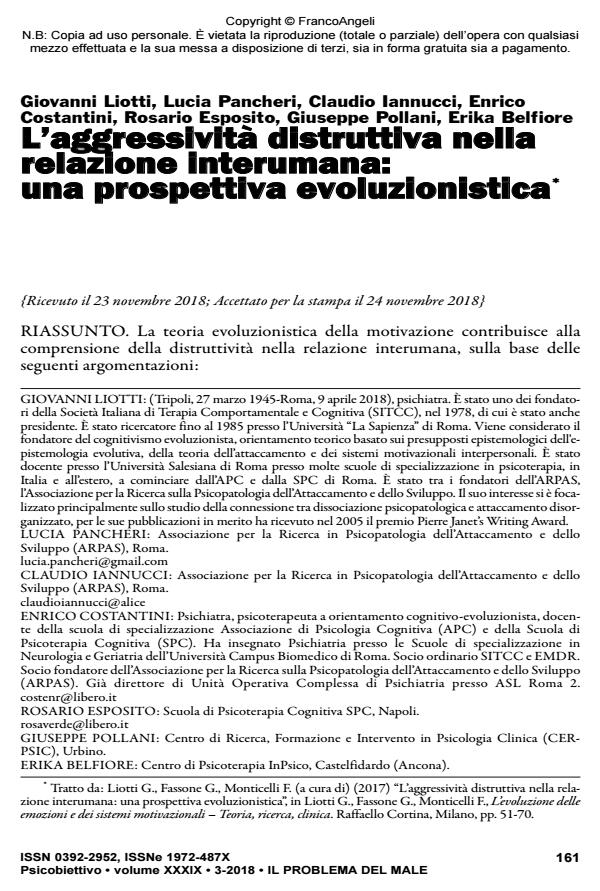Destructive aggression in the interhuman relation-ship: an evolutionary perspective
Journal title PSICOBIETTIVO
Author/s Giovanni Liotti, Lucia Pancheri, Claudio Iannucci, Enrico Costantini, Rosario Esposito, Giuseppe Pollani, Erika Belfiore
Publishing Year 2018 Issue 2018/3
Language Italian Pages 13 P. 161-173 File size 120 KB
DOI 10.3280/PSOB2018-003016
DOI is like a bar code for intellectual property: to have more infomation
click here
Below, you can see the article first page
If you want to buy this article in PDF format, you can do it, following the instructions to buy download credits

FrancoAngeli is member of Publishers International Linking Association, Inc (PILA), a not-for-profit association which run the CrossRef service enabling links to and from online scholarly content.
SUMMARY. The evolutionary theory of motivation contributes to the understanding of destructiveness in the interhuman relationship, based on the following arguments:
- there is a strong tendency that appeared in the course of evolution, as an evolutionarily stable strategy (ESS), to inhibit destructive aggression in clashes between conspecifics;
-some environmental conditions which can be defined sociologically and in humans can also be defined psychologically as they are linked to particular relationship contexts in which the personality development takes place, can weaken this tendency to the extent to cancel its effects;
- in the weakening of the inhibiting mechanism of violence (MoV), as even in its empowerment, motivations and higher mental functions intervene, which typically develop as evolutionary plumes;
- the weakening of MoV causes the actualization of two forms of destructiveness that can afflict the interhuman relationship, which is respectively connected to defense system for survival and the predatory system;
- the knowledge of the behavioral and emotional sequences, characteristic of the two systems, helps to clinically recognize the two forms of interhuman destructiveness in the study of psychopathology.
Keywords: Evolutionary Theory of Motivations (ETM); Aggression Inter-Speci-fic; Destructiveness; Inhibitory Mechanisms of Violence (MoV); Predation.
Giovanni Liotti, Lucia Pancheri, Claudio Iannucci, Enrico Costantini, Rosario Esposito, Giuseppe Pollani, Erika Belfiore, L’aggressività distruttiva nella relazione interumana: una prospettiva evoluzionistica in "PSICOBIETTIVO" 3/2018, pp 161-173, DOI: 10.3280/PSOB2018-003016